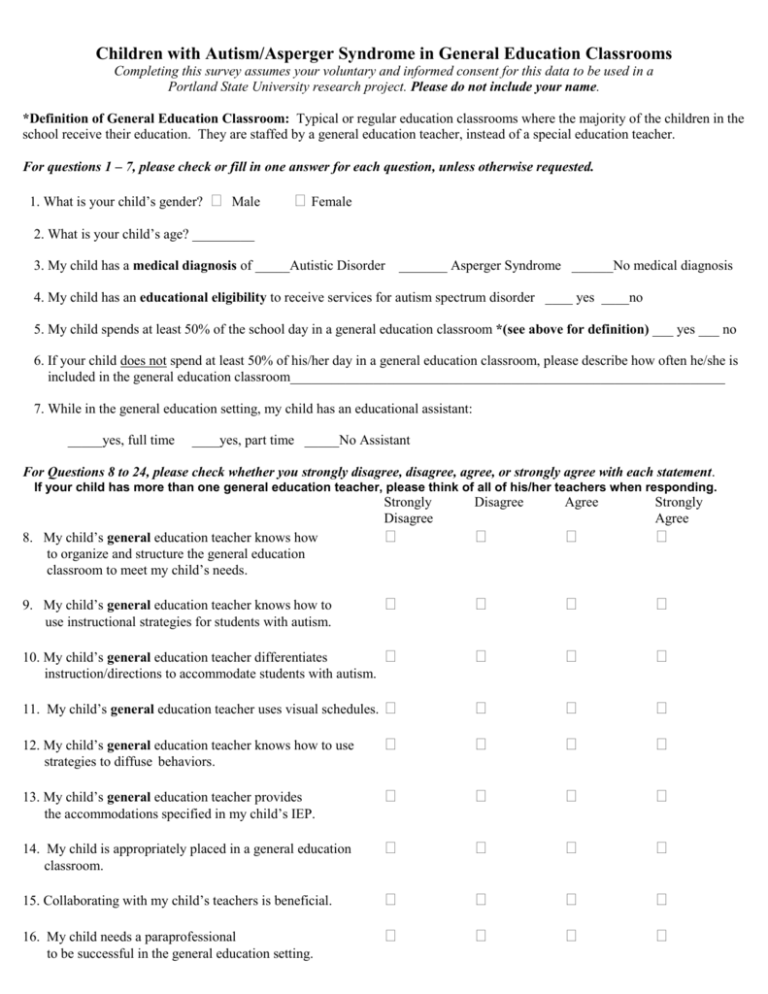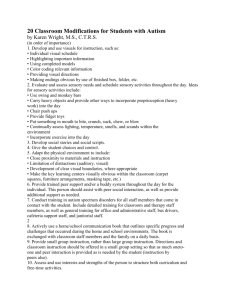here - Ellen Notbohm
advertisement

Children with Autism/Asperger Syndrome in General Education Classrooms Completing this survey assumes your voluntary and informed consent for this data to be used in a Portland State University research project. Please do not include your name. *Definition of General Education Classroom: Typical or regular education classrooms where the majority of the children in the school receive their education. They are staffed by a general education teacher, instead of a special education teacher. For questions 1 – 7, please check or fill in one answer for each question, unless otherwise requested. 1. What is your child’s gender? Male Female 2. What is your child’s age? _________ 3. My child has a medical diagnosis of _____Autistic Disorder _______ Asperger Syndrome ______No medical diagnosis 4. My child has an educational eligibility to receive services for autism spectrum disorder ____ yes ____no 5. My child spends at least 50% of the school day in a general education classroom *(see above for definition) ___ yes ___ no 6. If your child does not spend at least 50% of his/her day in a general education classroom, please describe how often he/she is included in the general education classroom_______________________________________________________________ 7. While in the general education setting, my child has an educational assistant: _____yes, full time ____yes, part time _____No Assistant For Questions 8 to 24, please check whether you strongly disagree, disagree, agree, or strongly agree with each statement. If your child has more than one general education teacher, please think of all of his/her teachers when responding. Strongly Disagree Disagree Agree Strongly Agree 8. My child’s general education teacher knows how to organize and structure the general education classroom to meet my child’s needs. 9. My child’s general education teacher knows how to use instructional strategies for students with autism. 10. My child’s general education teacher differentiates instruction/directions to accommodate students with autism. 11. My child’s general education teacher uses visual schedules. 12. My child’s general education teacher knows how to use strategies to diffuse behaviors. 13. My child’s general education teacher provides the accommodations specified in my child’s IEP. 14. My child is appropriately placed in a general education classroom. 15. Collaborating with my child’s teachers is beneficial. 16. My child needs a paraprofessional to be successful in the general education setting. Strongly Disagree Disagree Agree Strongly Agree 17. My child’s school district has enough resources (e.g., funds, trainers) to ensure that staff receive adequate training in how to teach children with autism. 18. My child’s general education teacher needs more training in effective strategies and interventions. 19. My child’s special education teacher needs more training in effective strategies and interventions. 20. Workshops for teachers and parents at my child’s school would be a good way to deliver training on effective strategies/interventions for children with autism spectrum disorders. 21. Courses presented online would be a good way to deliver training to parents and teachers on effective strategies and interventions for children with autism spectrum disorders 22. Follow-up hands-on training in the classroom will be needed to ensure the general and special education teachers understand how to use the strategies learned in group workshops or online. 23. Follow-up support or training will be needed to ensure parents understand how to use the strategies learned in group workshops or online. 24. If PSU receives a federal grant to train educators and parents to more effectively teach children with autism spectrum disorders, I would be interested in participating. 25. Please describe how you think school staff (e.g., special educators, general educators, paraprofessionals, speech language pathologists) are affected when children with autism spectrum disorders are included in the general education classroom (please include another piece of paper if you need more space to write): ________________________________________________________________________________________________________ ________________________________________________________________________________________________________ 26. Please describe how you think children with autism and their families are affected when children with autism are included in the general education classroom classroom (please include another piece of paper if you need more space to write): ________________________________________________________________________________________________________ ________________________________________________________________________________________________________ 27. Please describe what type of training is needed and how school staff and parents could best receive training to more effectively to teach children with autism (please include another piece of paper if you need more space to write): _______________________________________________________________________________________________________ ________________________________________________________________________________________________________ Thank you for your participation If you have any questions, please contact Dr. Helen Young at youngh@pdx.edu or 503-725-5207







